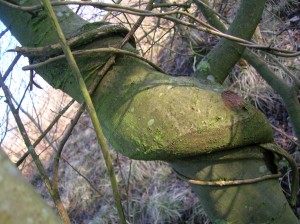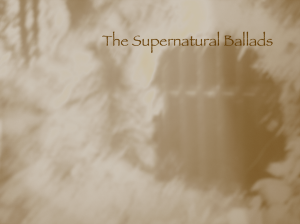Willie’s Ladye
This ballad was included in the Minstrelsy of the Scottish Border from the first edition of 1802, where it was printed in the second volume. Scott stated that the version he included was from “Mrs Brown of Falkland’s MS”. This version of this ballad was taken down from by Mrs Brown . He presents the ballad as a variant of that previously published by “Monk” Lewis in his book Tales of Wonder. Variants of the tale have been recorded in the Danish, Swedish and Norwegian ballad traditions, and narrative tale versions also exist.
Like “The Young Tam-lane”, this ballad contains rather disturbing subject matter and may be best avoided for younger children. It involves a curse laid on a pregant women, who cannot give birth to the unborn child until the spell is lifted.
Tradition
 Childbirth was recognised as a perilous time for the mother-to-be and also for the baby. There were a number of rituals commonly undertaken in various regions of Scotland to prevent complications arising during the birth, although these were often put down to the intervention of malign spirits. Untying knots and keeping locks unlocked during a woman’s labour were common throughout Scotland. Placing implements of iron at the bedhead and around the room was also common, to prevent the mother and / or the child being abducted by the fairies. Such ballad tales may have their origins in medical complications, which were not understood at the time. The belief in the possibility of malign intervention in everyday life was common in some parts of Scotland, certainly to the cusp of the 20th Century. Fear of the “evil eye” was most common, as noted in these tracks from Tobar an Dualchais.
Childbirth was recognised as a perilous time for the mother-to-be and also for the baby. There were a number of rituals commonly undertaken in various regions of Scotland to prevent complications arising during the birth, although these were often put down to the intervention of malign spirits. Untying knots and keeping locks unlocked during a woman’s labour were common throughout Scotland. Placing implements of iron at the bedhead and around the room was also common, to prevent the mother and / or the child being abducted by the fairies. Such ballad tales may have their origins in medical complications, which were not understood at the time. The belief in the possibility of malign intervention in everyday life was common in some parts of Scotland, certainly to the cusp of the 20th Century. Fear of the “evil eye” was most common, as noted in these tracks from Tobar an Dualchais.
Kate Ross, recorded by Calum Iain Maclean, 1955
Jeannie Robertson, recorded by Hamish Henderson, 1955
Murdo John MacLean, recorded by Calum Iain Maclean, 1955 (in Gaelic)
However, curses were also believed in, although the contributers often note that the “superstitions” people believed in, in the past are not prevalent at the time of records, as this account from James Laurenson:
James Laurenson, recorded by John Graham, 1959
This ballad presents curses, benign spirits, and the means to break malignant spells. The curse in this ballad has several components, most of which involve loosening knots or removing items which can cause tangling.
They are:
Nine witch knots, which must be untangled from her hair
Kaims o’ care, which must be removed from her hair
The bush o woodbine must be taken down. Woodbine is another word of honeysuckle. The suggestion, here, is that taking down the twisting, interlocking branches of the plant will help release the lady from her condition.
The left foot shoe – the show has to be loosened, again suggesting something which is tied tightly.
The “master” kid which run underneath the lady’s bed must be killed. There is a suggestion here that the young male animal passing under the woman’s bed is blocking the arrival of a male infant.
There were a number of traditions which were adhered to when women were in labour: all the locks in a house were undone, knives, nails or swords of iron were placed in the room to keep fairies at a distance. After a wedding, very often any knots on the wedding couples clothes were unfastened in the belief that this would speed conception. By inference, tying knots makes conception of birth difficult.
The Characters
There are several ballads which contain incidences of mothers opposing their children's wishes. Very often, these mothers demand that the child does or does not do something, warning that a catastrophe will occur if they defy the mother's wish. These characters may be viewed as practising magic at the very least, or, as in this case, they may be viewed as a malign witch. Another good example of a mother who curses their child can be found in versions of the ballad “Cyde's Waters”. Other mothers, such as the character in “The Wife of Usher's Well” seem to practice magic, but are not malign. The more familiar role of the opposing step-mother was originally fulfilled by mother characters.
